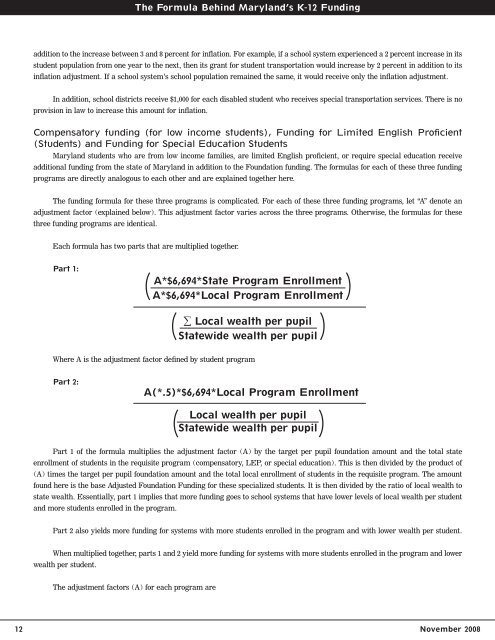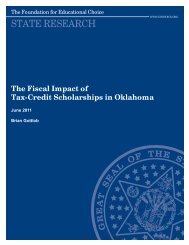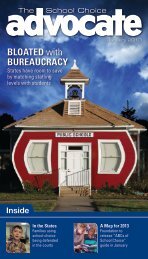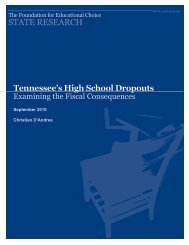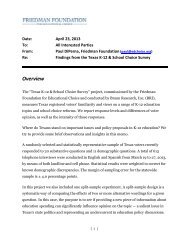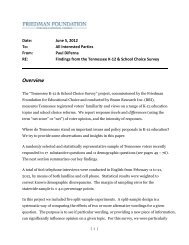View PDF - The Friedman Foundation For Educational Choice
View PDF - The Friedman Foundation For Educational Choice
View PDF - The Friedman Foundation For Educational Choice
Create successful ePaper yourself
Turn your PDF publications into a flip-book with our unique Google optimized e-Paper software.
<strong>The</strong> <strong>For</strong>mula Behind Maryland’s K-12 Funding<br />
)<br />
addition to the increase between 3 and 8 percent for inflation. <strong>For</strong> example, if a school system experienced a 2 percent increase in its<br />
student population from one year to the next, then its grant for student transportation would increase by 2 percent in addition to its<br />
inflation adjustment. If a school system’s school population remained the same, it would receive only the inflation adjustment.<br />
In addition, school districts receive $1,000 for each disabled student who receives special transportation services. <strong>The</strong>re is no<br />
provision in law to increase this amount for inflation.<br />
Compensatory funding (for low income students), Funding for Limited English Proficient<br />
(Students) and Funding for Special Education Students<br />
Maryland students who are from low income families, are limited English proficient, or require special education receive<br />
additional funding from the state of Maryland in addition to the <strong>Foundation</strong> funding. <strong>The</strong> formulas for each of these three funding<br />
programs are directly analogous to each other and are explained together here.<br />
<strong>The</strong> funding formula for these three programs is complicated. <strong>For</strong> each of these three funding programs, let “A” denote an<br />
adjustment factor (explained below). This adjustment factor varies across the three programs. Otherwise, the formulas for these<br />
three funding programs are identical.<br />
Each formula has two parts that are multiplied together.<br />
Part 1:<br />
A*$6,694*State Program Enrollment<br />
A*$6,694*Local Program Enrollment<br />
)<br />
∑ Local wealth per pupil<br />
Statewide wealth per pupil<br />
)<br />
)<br />
Where A is the adjustment factor defined by student program<br />
Part 2:<br />
A(*.5)*$6,694*Local Program Enrollment<br />
)<br />
Local wealth per pupil<br />
Statewide wealth per pupil<br />
)<br />
Part 1 of the formula multiplies the adjustment factor (A) by the target per pupil foundation amount and the total state<br />
enrollment of students in the requisite program (compensatory, LEP, or special education). This is then divided by the product of<br />
(A) times the target per pupil foundation amount and the total local enrollment of students in the requisite program. <strong>The</strong> amount<br />
found here is the base Adjusted <strong>Foundation</strong> Funding for these specialized students. It is then divided by the ratio of local wealth to<br />
state wealth. Essentially, part 1 implies that more funding goes to school systems that have lower levels of local wealth per student<br />
and more students enrolled in the program.<br />
Part 2 also yields more funding for systems with more students enrolled in the program and with lower wealth per student.<br />
When multiplied together, parts 1 and 2 yield more funding for systems with more students enrolled in the program and lower<br />
wealth per student.<br />
<strong>The</strong> adjustment factors (A) for each program are<br />
12 November 2008


